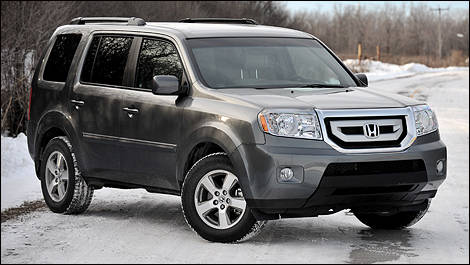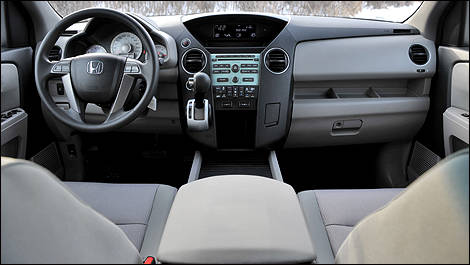Honda's line-up can seem ironic sometimes. On one end, the Fit subcompact maximizes interior space in a small package. On the other end, the Pilot SUV is big inside and out, but manages to feel like a much smaller vehicle.
How can they achieve that with the Pilot? Two things stand out: the truck's interior packaging takes advantage of the boxy exterior shape, and its turning radius is among the narrowest of its category, which makes parking it very easy.
It's big inside; it's one of very few trucks that can accommodate 8 passengers—make that 8 adults. The third row of seats is fine for relatively long trips because there's no compromise in foot room. In addition, the second-row seat gets out of the way relatively easy, which helps people access the last row.
Cargo space with both rows of seats folded down is 2,464 litres, which is bigger than in the Nissan Pathfinder, Ford Flex and Jeep Commander, but smaller than in the Mazda CX-9, Kia Borrego, Toyota Highlander and Chevrolet Traverse/GMC Acadia. The tailgate window can be opened separately for quickly dumping stuff in back.
Curiously, front-seat space isn't as generous as one would expect, but the trade-off is a versatile floor console that includes cupholders and can hide away your precious possessions that could interest crowbar-toting thugs. The material that covers the seats and door panels is sturdy, but at the same time looks a little too industrial.
The control layout is pretty simple to use and the sound system performs well. Rear-seat occupants of our EX tester get an automatic climate control system that can be overrided up front; a good thing, since my kids can't resist playing with it. We just wish the dash didn't look so plasticky, with grainy textures and visible cut lines.
Power comes from Honda's ubiquitous 3.5-litre V6. In the Pilot, it develops 250 horsepower and 253 lb-ft of torque, and every version now comes with cylinder deactivation, which Honda calls Advanced-VCM. The system basically shuts off 2 or 3 cylinders when full power is not needed. All this is to save fuel, which seems to work a little: our average of 11.9 L/100 km is good, but it does include a trip from Montreal to New Hampshire and back.
 |
| The Pilot represents what most mid-size SUV shoppers are looking for. |
How can they achieve that with the Pilot? Two things stand out: the truck's interior packaging takes advantage of the boxy exterior shape, and its turning radius is among the narrowest of its category, which makes parking it very easy.
It's big inside; it's one of very few trucks that can accommodate 8 passengers—make that 8 adults. The third row of seats is fine for relatively long trips because there's no compromise in foot room. In addition, the second-row seat gets out of the way relatively easy, which helps people access the last row.
Cargo space with both rows of seats folded down is 2,464 litres, which is bigger than in the Nissan Pathfinder, Ford Flex and Jeep Commander, but smaller than in the Mazda CX-9, Kia Borrego, Toyota Highlander and Chevrolet Traverse/GMC Acadia. The tailgate window can be opened separately for quickly dumping stuff in back.
Curiously, front-seat space isn't as generous as one would expect, but the trade-off is a versatile floor console that includes cupholders and can hide away your precious possessions that could interest crowbar-toting thugs. The material that covers the seats and door panels is sturdy, but at the same time looks a little too industrial.
The control layout is pretty simple to use and the sound system performs well. Rear-seat occupants of our EX tester get an automatic climate control system that can be overrided up front; a good thing, since my kids can't resist playing with it. We just wish the dash didn't look so plasticky, with grainy textures and visible cut lines.
Power comes from Honda's ubiquitous 3.5-litre V6. In the Pilot, it develops 250 horsepower and 253 lb-ft of torque, and every version now comes with cylinder deactivation, which Honda calls Advanced-VCM. The system basically shuts off 2 or 3 cylinders when full power is not needed. All this is to save fuel, which seems to work a little: our average of 11.9 L/100 km is good, but it does include a trip from Montreal to New Hampshire and back.
 |
| The control layout is pretty simple to use and the sound system performs well. |





